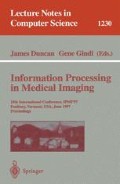Abstract
Virtual reality environments provide highly interactive, natural control of the visualization process, significantly enhancing the scientific value of the data produced by medical imaging systems. Due to the computational and real time display update requirements of virtual reality interfaces, however, the complexity of organ and tissue surfaces which can be displayed is limited. In this paper, we present a new algorithm for the production of a polygonal surface containing a pre-specified number of polygons, from patient or subject specific volumetric image data, selected to optimize the trade-off between surface detail and real time display rates of anatomic models. To illustrate the utility of these models we also present a brief overview of their application in virtual endoscopy and surgery rehearsal.
Preview
Unable to display preview. Download preview PDF.
References
R.A. Robb, ”Surgery simulation with ANALYZE/AVW: a visualization workshop for 3-D display and analysis of multimodality medical images”, Proc. of Medicine Meets Virtual Reality II, San Diego, CA, 1994
B. Fritzke, ”Let it grow — self organizing feature maps with problem dependent cell structure”, Proc. of the ICANN-91, Helsinki, 1991
B. Fritzke, ”A growing neural gas network learns topologies.”, in Advances in Neural Information Processing Systems 7, Eds. G. Teasauro, S. Touretzky and T.K. Leen. MIT Press, Cambridge MA, 1995
T. Kohonen, Self-organization and associative memory (3rd Ed), Springer-Verlag, Berlin, 1989
T.M. Martinetz, ”Competitive Hebbian Learning rule forms perfectly topology preserving maps”, In CANN'93: International Conference on artificial Neural Network, Amsterdam, Springer, 1993, 427–434
H. Hoppe, ”Surface reconstruction from unorganized points”, Doctoral Dissertation, University of Washington, 1994
Author information
Authors and Affiliations
Editor information
Rights and permissions
Copyright information
© 1997 Springer-Verlag Berlin Heidelberg
About this paper
Cite this paper
Aharon, S., Cameron, B.M., Robb, R.A. (1997). Computation of efficient patient specific models from 3-D medical images: Use in virtual endoscopy and surgery rehearsal. In: Duncan, J., Gindi, G. (eds) Information Processing in Medical Imaging. IPMI 1997. Lecture Notes in Computer Science, vol 1230. Springer, Berlin, Heidelberg. https://doi.org/10.1007/3-540-63046-5_38
Download citation
DOI: https://doi.org/10.1007/3-540-63046-5_38
Published:
Publisher Name: Springer, Berlin, Heidelberg
Print ISBN: 978-3-540-63046-3
Online ISBN: 978-3-540-69070-2
eBook Packages: Springer Book Archive

